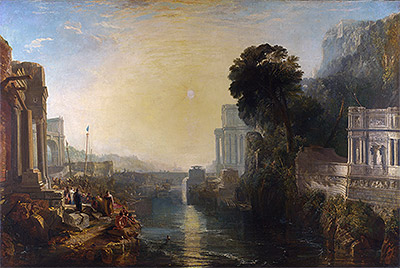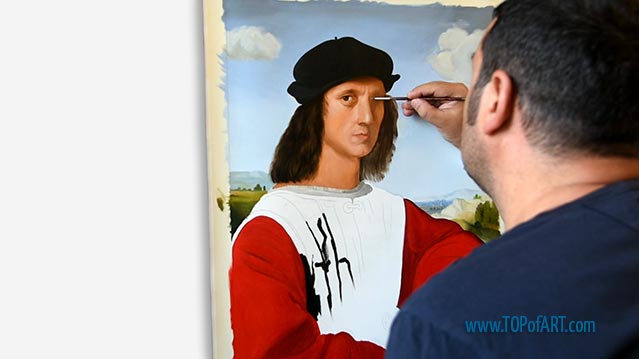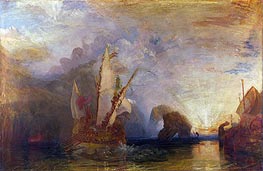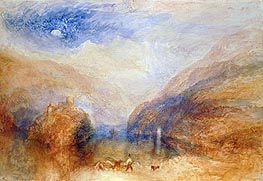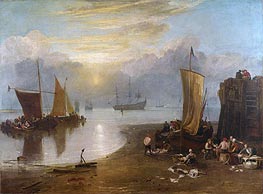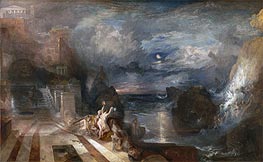Dido Building Carthage (The Rise of the Carthaginian Empire), 1815 Joseph Mallord William Turner (1775-1851)
Location: National Gallery London UKOriginal Size: 155.5 x 230 cm
Oil Painting Reproduction
If you want a different size than the offered
Description
Painted by European Аrtists with Academic Education
Museum Quality
+ 4 cm (1.6") Margins for Stretching
Creation Time: 8-9 Weeks
Creation Process
We create our paintings with museum quality and covering the highest academic standards. Once we get your order, it will be entirely hand-painted with oil on canvas. All the materials we use are the highest level, being totally artist graded painting materials and linen canvas.
We will add 1.6" (4 cm) additional blank canvas all over the painting for stretching.
High quality and detailing in every inch are time consuming. The reproduction of Joseph Mallord William Turner also needs time to dry in order to be completely ready for shipping, as this is crucial to not be damaged during transportation.
Based on the size, level of detail and complexity we need 8-9 weeks to complete the process.
In case the delivery date needs to be extended in time, or we are overloaded with requests, there will be an email sent to you sharing the new timelines of production and delivery.
TOPofART wants to remind you to keep patient, in order to get you the highest quality, being our mission to fulfill your expectations.
We not stretch and frame our oil paintings due to several reasons:
Painting reproduction is a high quality expensive product, which we cannot risk to damage by sending it being stretched.
Also, there are postal restrictions, regarding the size of the shipment.
Additionally, due to the dimensions of the stretched canvas, the shipment price may exceed the price of the product itself.
You can stretch and frame your painting in your local frame-shop.
Delivery
Once the painting Dido Building Carthage (The Rise of the Carthaginian Empire) is ready and dry, it will be shipped to your delivery address. The canvas will be rolled-up in a secure postal tube.
We offer free shipping as well as paid express transportation services.
After adding your artwork to the shopping cart, you will be able to check the delivery price using the Estimate Shipping and Tax tool.
Museum Quality
The paintings we create are only of museum quality. Our academy graduated artists will never allow a compromise in the quality and detail of the ordered painting. TOPofART do not work, and will never allow ourselves to work with low quality studios from the Far East. We are based in Europe, and quality is our highest priority.
Additional Information
Colour is marshalled with calculated restraint. Turner bathes the architecture in honeyed light, allowing ochres and umbers to dissolve into a warm haze, while the water adopts a tempered turquoise that anchors the transient luminosity. A single azure pennant, hoisted on a mast, echoes Dido’s gown and punctuates the dominance of yellows and earths. This orchestration of hues imparts both serenity and foreboding: the chromatic harmony lulls, yet the underlying tonal contrasts foretell a drama still latent.
Up close, the painting reveals Turner’s dual temperament: the disciplined draughtsman and the experimental virtuoso. Architectural profiles are laid in with firm, linear precision reminiscent of Claude, but the surrounding atmosphere is conjured through flicks and swirls of translucent glaze. Pigment accumulates in scintillating layers, enabling the sky to throb with internal light, while the rippling water is rendered by dragging a nearly dry brush across still‑wet paint, catching ridges to suggest fleeting reflections.
Compositionally, Turner adopts Claude’s classical formula—symmetrical framing, central waterway, repoussoir foliage—yet he complicates it with narrative density. Figures are scaled diminutively, subordinated to the monumental setting, reinforcing themes of civic aspiration dwarfed by natural and temporal forces. The vertical thrust of the dark central tree interrupts the lateral spread, a reminder of organic unpredictability within human design. Subtle diagonals, from rocky ledge to receding breakwater, shepherd the gaze deeper, only to halt at the glowing void of the rising sun: history converging upon an unknowable future.
Painted in 1815, within the aftermath of Napoleonic upheaval, the work serves as a meditation on empire—its construction, promise and inevitable decay. Turner, steeped in Dryden’s Virgil, juxtaposes Dido’s industrious capital with an atmosphere already tinged by elegy. In pairing this canvas with the later Decline of the Carthaginian Empire, he stages a visual diptych on ambition’s arc. Yet here, at the moment of ascent, hope and melancholy are held in immaculate suspension, the artist’s luminous veil both revealing and obscuring the fate inscribed in legend.
